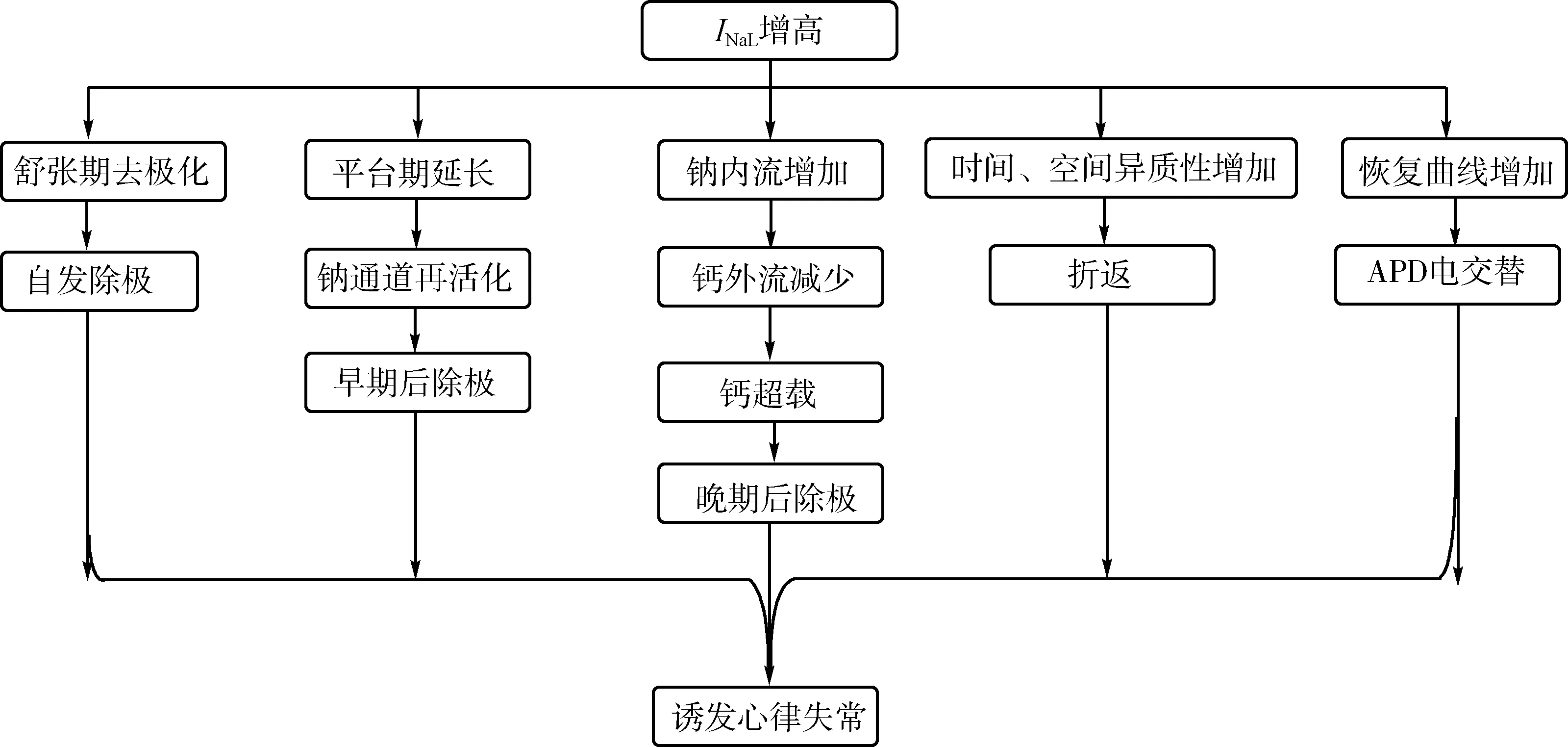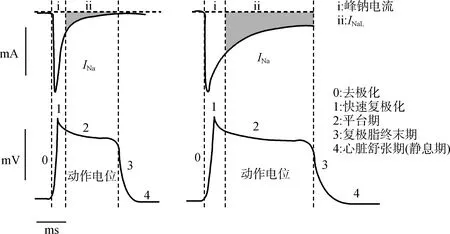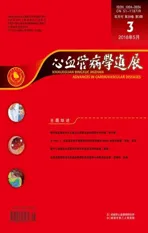晚钠电流及其速率依赖性在急性心肌梗死后心律失常发生机制中的作用
2018-06-04王梁综述李晶洁审校
王梁 综述 李晶洁,2 审校
(1.哈尔滨医科大学附属第一医院,黑龙江 哈尔滨 150000; 2.哈尔滨医科大学附属第一医院心内科,黑龙江 哈尔滨 150000)
室性心律失常所致的心源性猝死每年可导致全球4~5百万人的死亡,其中心肌梗死是导致室性心律失常的主要原因之一[1-2]。心律失常起因于动作电位的激动顺序,传播和恢复出现异常,这些步骤是通过电压门控离子通道的打开和关闭来完成的。急性心肌梗死(acute myocardial infarction,AMI)可导致心肌细胞离子电流的功能出现异常,最终导致细胞内钙超载,进而对心肌细胞造成结构性和功能性的损伤[3]。
1 晚钠电流
1.1 晚钠电流的定义及生理功能
1.2 INaL在AMI后的病理学改变
利用细胞膜片钳技术发现,在AMI后心肌的代谢产物、过氧化氢、缺氧可导致INaL幅度明显增加[5-7],Na+内流显著增加引起的胞内钠超载,能够激活钠钙交换体,继而导致钙内流增加,引发钙超载[8-10]。因此,INaL被广泛认为是钠钾交换(Na+/K+)的核心,同时影响钠钙交换体(Na+/Ca2+exchanger,NCX)及钠氢交换体(Na+/H+exchanger,NHE),从而影响离子平衡[11-13]。
1.3 INaL在心律失常中的作用

图1 INaL增高促进心律失常的发生机制

图2 INaL与动作电位时程之间的关系
1.4 阻断INaL对AMI后心脏的作用
2 速率依赖性
2.1 速率依赖性及其作用
哺乳动物心室肌复极化(由体表心电图上的QT间期表示)与心率成反比,即心率加快,动作电位时程(action potential duration,APD)/QT间期缩短;心率减慢,APD/QT间期延长[27]。也就是说,心动过速通常会缩短心室复极化并使其延长。这种特性称之为速率依赖性。心室动作电位的持续时间由细胞膜中通道的向内和向外离子电流的动态平衡来确定。理论上,与速率相关的变化离子通道(打开、关闭、灭活)的三种状态中的任何一种可以影响通道的激活、失活和恢复,并且随后转化为APD/QT的变化。
2.2 速率依赖性与INaL之间的关系
3 结语与展望
在急性心肌缺血事件发生时,由于不同部位血管阻塞所致的梗死部位的差异,INaL的增强也相应具有异质性。与此同时,在由AMI导致的不同类型心律失常(缓慢型或快速型)情况下,INaL及其速率依赖性(即在心率加快时,表达减少;在心率减慢时,表达增多)在AMI中的作用具有差异,对临床个体化治疗也提出了更高的要求。因此,在急性心肌缺血事件所致的缓慢型心律失常与快速型心律失常的情况下,抑制INaL是否具有明显差异?是否依然可以促进缺血的心肌获益?这仍是需探讨解决的。
[ 参 考 文 献 ]
[1] Chugh SS,Reinier K,Teodorescu C,et al.Epidemiology of sudden cardiac death:clinical and research implications[J].Prog Cardiovasc Dis,2008,51(3):213-228.
[2] McCorquodale A,Poulton R,Hendry J,et al.High prevalence of early repolarization in the paediatric relatives of sudden arrhythmic death syndrome victims and in normal controls[J].Europace,2017,19(8):1385-1391.
[3] Bernink FJ,Timmers L,Beek AM,et al.Progression in attenuating myocardial reperfusion injury:an overview[J].Int J Cardiol,2014,170(3):261-269.
[4] Makielski JC,Farley AL.Na(+)current in human ventricle:implications for sodium loading and homeostasis[J].J Cardiovasc Electrophysiol,2006,17(Suppl 1):15-20.
[5] Aldakkak M,Camara AK,Heisner JS,et al.Ranolazine reduces Ca2+overload and oxidative stress and improves mitochondrial integrity to protect against ischemia reperfusion injury in isolated hearts[J].Pharmacol Res,2011,64(4):381-392.
[6] Tang Q,Ma J,Zhang P,et al.Persistent sodium current and Na+/H+exchange contributes to the augmentation of the reverse Na+/Ca2+exchange during hypoxia or acute ischemia in ventricular myocytes[J].Pflugers Arch,2012,463(4):513-522.
[7] Song Y,Shryock JC,Wagner S,et al.Blocking late sodium current reduces hydrogen peroxide-induced arrhythmogenic activity and contractile dysfunction[J].J Pharmacol Exp Ther,2006,318(1):214-222.
[8] Ronchi C,Torre E,Rizzetto R,et al.Late sodium current and intracellular ionic homeostasis in acute ischemia[J].Basic Res Cardiol,2017,112(2):12.
[9] Sossalla S,Maier LS.Role of ranolazine in angina,heart failure,arrhythmias,and diabetes[J].Pharmacol Ther,2012,133(3):311-323.
[10] Noble D,Noble NJ.Late sodium current in the pathophysiology of cardiovascular disease:consequences of sodium-calcium overload[J].Heart,2006,92(Suppl 4):iv1-iv5.
[11] Chen S,Li S.The Na+/Ca2+exchanger in cardiac ischemia/reperfusion injury[J].Med Sci Monit,2012,18(11):61-65.
[12] Madonna R,Caterina RD.Sodium-hydrogen exchangers(NHE)in human cardiovascular diseases:interfering strategies and their therapeutic applications[J].Vascul Pharmacol,2013,59(5-6):127-130.
[13] Luongo TS,Lambert JP,Gross P,et al.The mitochondrial Na(+)/Ca(2+)exchanger is essential for Ca(2+)homeostasis and viability[J].Nature,2017,545(7652):93-97.
[14] Gaztanaga L,Marchlinski EF,Betensky BP.Mechanisms of cardiac arrhythmias[J].Rev Esp Cardiol(Engl Ed),2012,65(2):174-185.
[15] Song Y,Shryock JC,Belardinelli L.A slowly inactivating sodium current contributes to spontaneous diastolic depolarization of atrial myocytes[J].Am J Physiol Heart Circ Physiol,2009,297(4):1254-1262.
[16] Anumonwo JM,Pandit SV.Ionic mechanisms of arrhythmogenesis[J].Trends Cardiovasc Med,2015,25(6):487-496.
[17] Mjahad A,Rosado-Munoz A,Bataller-Mompean M,et al.Ventricular fibrillation and tachycardia detection from surface ECG using time-frequency representation images as input dataset for machine learning[J].Comput Methods Programs Biomed,2017,141:119-127.
[18] Sato D,Clancy CE,Bers DM.Dynamics of sodium current mediated early afterdepolarizations[J].Heliyon,2017,3(9):00388.
[19] Antzelevitch C,Nesterenko V,Shryock JC,et al.The role of late INa in development of cardiac arrhythmias[J].Handb Exp Pharmacol,2014,221:137-168.
[20] Chillou C,Sellal JM,Magnin-Poull I.Pace mapping to localize the critical isthmus of ventricular tachycardia[J].Card Electrophysiol Clin,2017,9(1):71-80.
[21] Taggart P,Lab M.Cardiac mechano-electric feedback and electrical restitution in humans[J].Prog Biophys Mol Biol,2008,97(2-3):452-460.
[22] Gomes JM,Dos Santos RW,Cherry EM.Alternans promotion in cardiac electrophysiology models by delay differential equations[J].Chaos,2017,27(9):093915.
[23] Calderon-Sanchez EM,Dominguez-Rodriguez A,Lopez-Haldon J,et al.Cardioprotective effect of ranolazine in the process of ischemia-reperfusion in adult rat cardiomyocytes[J].Rev Esp Cardiol(Engl Ed),2016,69(1):45-53.
[24] Hale SL,Leeka JA,Kloner RA.Improved left ventricular function and reduced necrosis after myocardial ischemia/reperfusion in rabbits treated with ranolazine,an inhibitor of the late sodium channel[J].J Pharmacol Exp Ther,2006,318(1):418-423.
[25] Undrovinas AI,Belardinelli L,Undrovinas NA,et al.Ranolazine improves abnormal repolarization and contraction in left ventricular myocytes of dogs with heart failure by inhibiting late sodium current[J].J Cardiovasc Electrophysiol,2006,17(Suppl 1):169-177.
[26] Hwang H,Arcidi JM,Belardinelli AK,et al.Ranolazine as a cardioplegia additive improves recovery of diastolic function in isolated rat hearts[J].Circulation,2009,120(11 Suppl):16-21.
[27] Burashnikov A,Shimizu W,Antzelevitch C.Fever accentuates transmural dispersion of repolarization and facilitates development of early afterdepolarizations and torsade de pointes under long-QT Conditions[J].Circ Arrhythm Electrophysiol,2008,1(3):202-208.
[28] Antzelevitch C,Shimizu W,Yan GX,et al.The M cell:its contribution to the ECG and to normal and abnormal electrical function of the heart[J].J Cardiovasc Electrophysiol,1999,10(8):1124-1152.
[29] Maltsev VA,Silverman N,Sabbah HM,et al.Chronic heart failure slows late sodium current in human and canine ventricular myocytes:implications for repolarization variability[J].Eur J Heart Fail,2007,9(3):219-227.
[30] Mishra S,Reznikov V,Maltsev VA,et al.Contribution of sodium channel neuronal isoform Nav1.1 to late sodium current in ventricular myocytes from failing hearts[J].J Physiol,2015,593(6):1409-1427.
[31] Guo D,Lian J,Liu T,et al.Contribution of late sodium current(I(Na-L))to rate adaptation of ventricular repolarization and reverse use-dependence of QT-prolonging agents[J].Heart Rhythm,2011,8(5):762-769.
[32] Undrovinas A,Maltsev VA.Late sodium current is a new therapeutic target to improve contractility and rhythm in failing heart[J].Cardiovasc Hematol Agents Med Chem,2008,6(4):348-359.
[33] Persson F,Andersson B,Duker G,et al.Functional effects of the late sodium current inhibition by AZD7009 and lidocaine in rabbit isolated atrial and ventricular tissue and Purkinje fibre[J].Eur J Pharmacol,2007,558(1-3):133-143.
